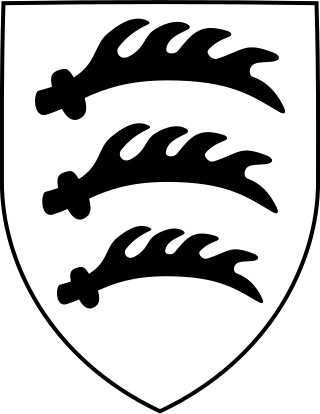
The 6th SS Mountain Division Nord was a World War II mountain infantry division of the Waffen-SS, the military wing of the German Nazi Party, primarily consisting of ethnic Germans along with some Norwegian and Swiss volunteers. It was the only Waffen-SS division to operate in the Arctic Circle.

The 13th Panzer Division was a unit of the German Army during World War II, established in 1940.

The 16th Infantry Division of the German Army was formed in 1934. On 26 August 1939 the division was mobilized for the invasion of Poland (1939). It participated in the Battle of France in August 1940. The division was then split, resulting in two independent units: The 16th Panzer Division and the 16th Motorized Infantry Division. Then later, from 1944 onward, combined with other non 16th elements, was known as the 116th Panzer Division.

The 78th Infantry Division, later known as the 78th Assault Division, was a German infantry formation which fought during World War II. After the 78th Assault Division was destroyed near Minsk in July 1944, the 78th Volksgrenadier Division was created.

The 6th Panzer Division was an armoured division in the German Army, the Heer, during World War II, established in October 1939.
XXXXVIII Panzer Corps, was a corps-level formation of the German Army which saw extensive action on both the Eastern and Western Fronts during World War II.

The 12th Infantry Division – later known as the 12th Volksgrenadier Division – was a Wehrmacht military unit of Nazi Germany that fought during World War II. The division was formed in 1934. It participated in the invasion of Poland in 1939 and the 1940 campaign in France and the Low Countries. In the Soviet Union, the division joined Operation Barbarossa. The division was destroyed in the Soviet Operation Bagration in the summer of 1944. The division was re-activated in September 1944 and posted to the newly created Western Front.

The XXXIX Panzer Corps was a German panzer corps which saw action on the Western and Eastern Fronts during World War II.

The 216th Infantry Division was a German Army division that was created during the Second World War; it was active from 1939–1943. It served on the Western Front in 1940 and later took part in the Eastern Front campaign, being involved in the disastrous Battle of Kursk.

XLVII Panzer Corps was a panzer corps of the German Army in World War II that was formerly designated as XLVII Corps. Various formations of the corps fought in the French campaign of 1940, in the invasion of Soviet Union from 1941 to 1944, and on the Western Front from June 1944 until April 1945.

The 268th Infantry Division was a German Army division active and operating during the Second World War.

The 340th Volksgrenadier Division was a volksgrenadier division of the German Army during the Second World War, active from 1944 to 1945.

The 25th Infantry Division was a military unit of the German Wehrmacht. It was later reclassified to 25th Motorized Infantry Division, and in June 1943 to the 25th Panzergrenadier Division.
Alexander Conrady was a German general during World War II who commanded the 36th Infantry Division. He was a recipient of the Knight's Cross of the Iron Cross with Oak Leaves of Nazi Germany. Conrady was taken prisoner by Soviet troops during Operation Bagration on the night of the 30th of June 1944 while traveling in a halftrack containing two other German Generals, General Hoffmeister and General Engel. They had originally been reported missing but it was later revealed that they were captured. He was released in 1955.

The 24th Infantry Division was a German Army infantry division active in World War II. It served across the Eastern Front in engagements such as the Sieges of Sevastopol and the Leningrad, finally being destroyed in the Courland Pocket in 1945.

The 31st Infantry Division was a German infantry division of the Army during World War II. It participated in the invasion of Poland in 1939 then the invasion of France and the Low Countries in 1940. As part of Panzergruppe 2. of Army Group Centre, it was involved in the invasion of the Soviet Union in June 1941. After hard fighting throughout 1941 and 1942 it joined the 9th Army and fought in the Battle of Kursk in July and August 1943. Along with the rest of the 9th Army, the division conducted a fighting withdrawal for the remainder of 1943, during which it sustained heavy casualties. In the early stages of the Soviet Operation Bagration of June to August 1944, the 31st Infantry Division was destroyed, a fate which subsequently befell most of Army Group Centre. The division was officially disbanded on 18 July 1944.
The 220th Rifle Division was briefly a Red Army motorized infantry division that was re-organised shortly after the German invasion as a standard rifle division.
The 361st Infantry Division was an infantry division of the German Army during the Second World War, active from 1943 to 1945. It was redesignated as a Volksgrenadier division in 1944. It saw active service on the Eastern Front when the Soviets launched Operation Bagration, during which it suffered significant losses. It later fought in France before being absorbed by the 559th Volksgrenadier Division on 10 March 1945.
The 215th Rifle Division was an infantry division of the Red Army during World War II that continued to serve in the Soviet Army during the early years of the Cold War. It was the successor to a motorized division of that same number that was destroyed during the Battle of Kiev in September 1941.

The 211th Infantry Division was a German infantry division of the German Heer during World War II, active from 1939 to 1944.















